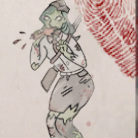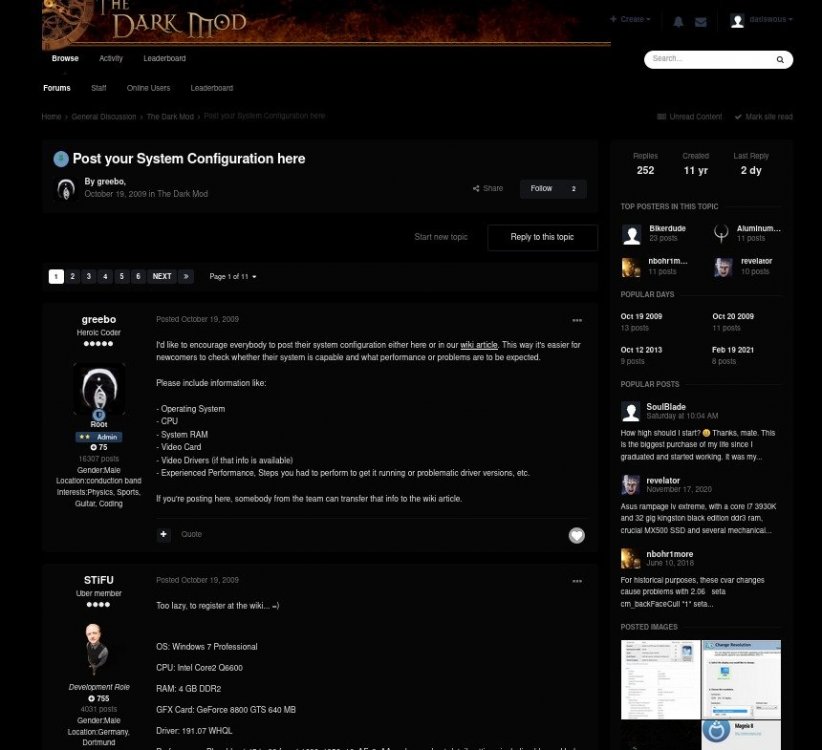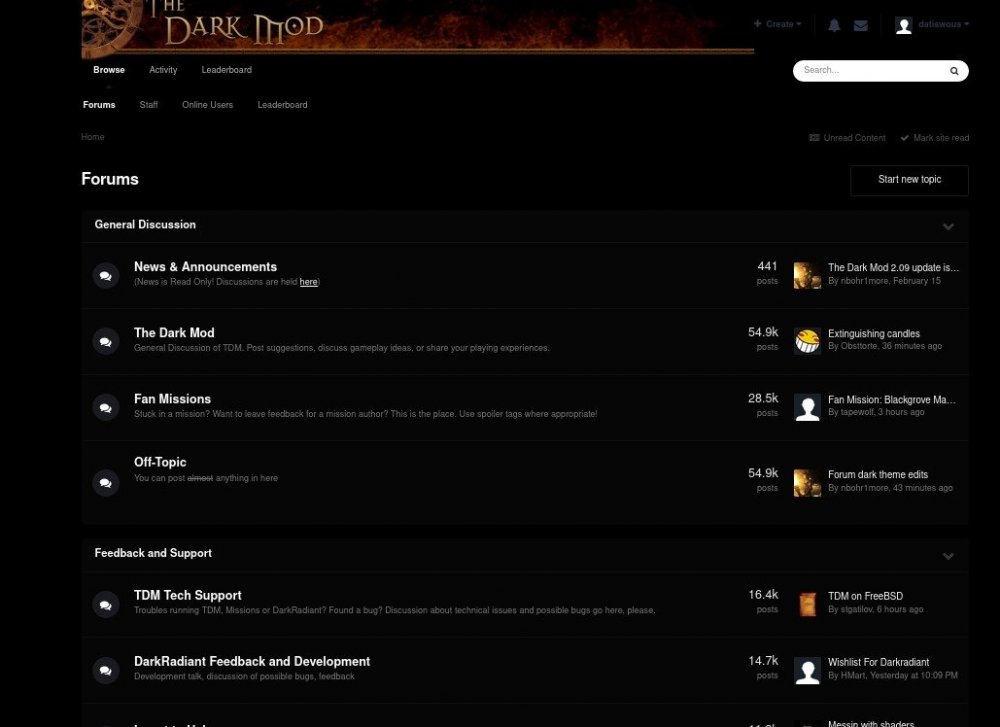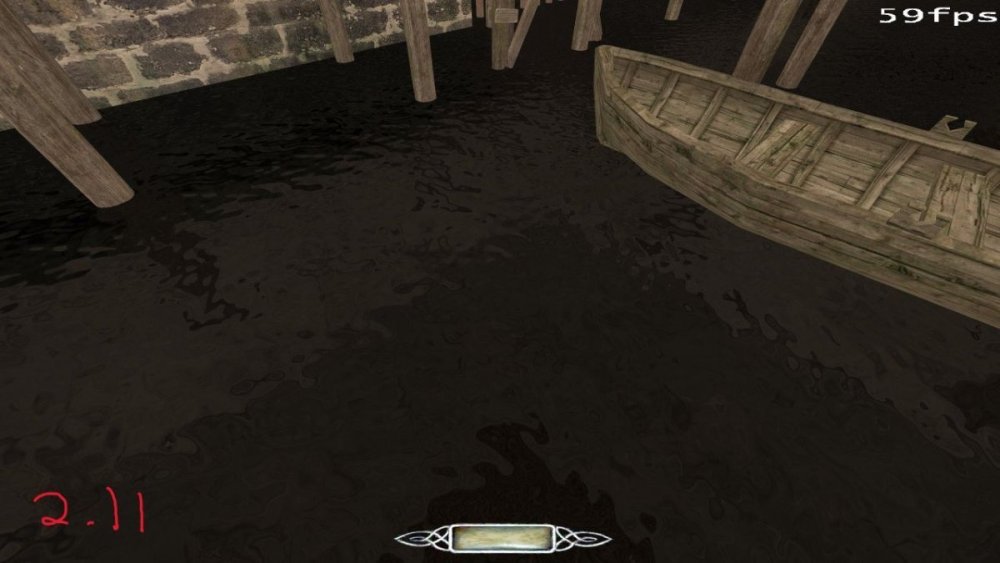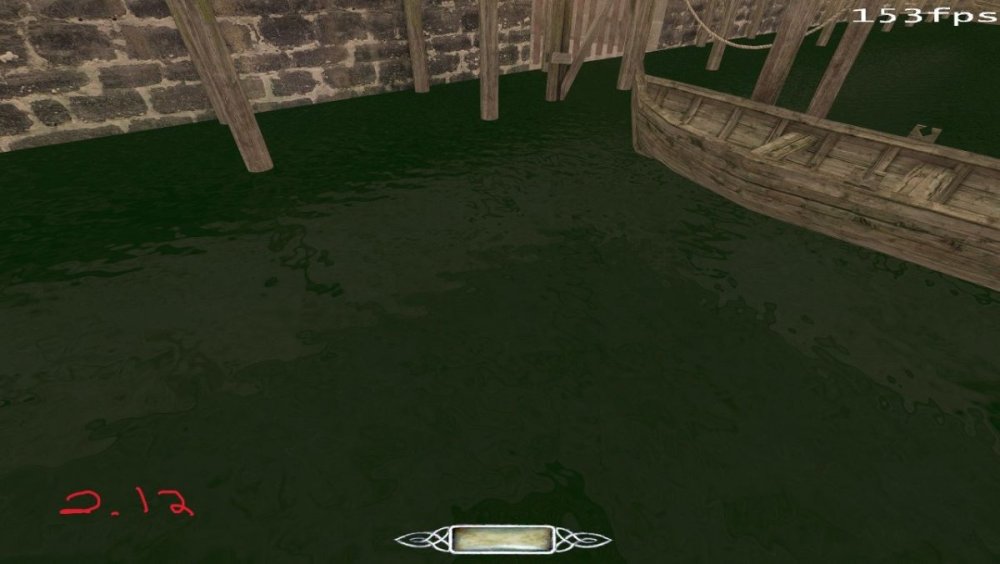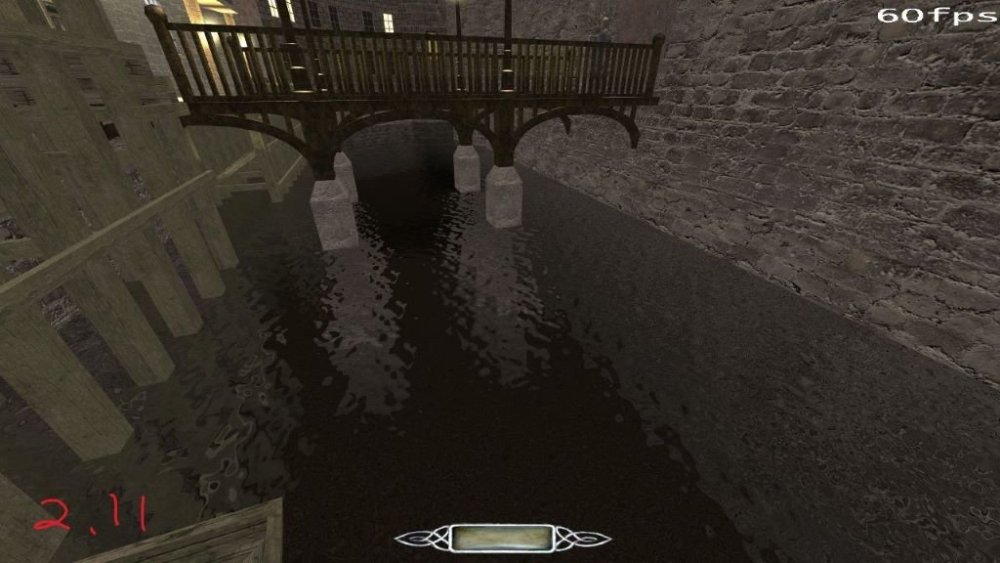Search the Community
Searched results for '/tags/forums/dark radiant/' or tags 'forums/dark radiant/q=/tags/forums/dark radiant/&'.
-
Hey everyone, since The Dark Mod 2.10 has been released, will the version 2.11 release with bugfixes?
-
I just dreamed that I was on a Dark Tranquility concert and then the vocalist took me out of the massive crowd on the stage just to leave it with me and the band together. We went to the back stage where they showed me a game they were developing with the crowd outside waiting for the next song. Then we went out for dinner and ice skating in an abandoned mall. lol
-
-
 3
3
-
- Report
- Show previous comments 2 more
-

-

@freykWell I'm not sure what to search for in the dictionary, since it was a pretty complex situation. My guess would be that I miss the guys from DT and the live concerts.. and the alcohol haha

-

In the following dreamsymbols dictionary
http://m.dreammoods.com/site/dreammoods#2843
Search for keywords: concert, vocal, stage, etc.
-
-
 1
1
-
- Report
-
The devs didn't title this thread, and @datiswous said they're attempting to mislead people by using Russell's name and a retro style to make it resemble Thief, which is cynical. I grew up on forums like I'm sure anyone who likes a game from '98 did. I actually left the Discord immediately after joining it because it was more off-topic doom-posting than anything relevant to the mod. I thought the forums might be better, but it's mostly just grown men yelling at clouds and telling strangers how mature they are, and a few brave souls actually developing anything. Depressing place, I'll just stick to enjoying new missions every 6 months without an account.
-
True, but, 1. this thread is called "Western stealth FPS with Stephen Russell", and, 2. nothing you said changes anything for me. The gameplay still doesn't look like something I'd enjoy. And, if you really think this forum is cynical, then you don't visit forums much. Actually, the majority of the users are are pretty mature, unlike in other forums.
-
Fresnel Mod has been updated: https://www.moddb.com/mods/the-dark-mod/addons/fresnel-mod-212-beta-3
-

Help Wanted: Beta Testers -- "The Terrible Old Man"
Ansome replied to Ansome's topic in Fan Missions
-Do forgive the screenshots being a bit dark or vague in this post, I can only show so much without spoiling the second half of this FM that is best experienced firsthand. -

New Git repository for DarkRadiant
AluminumHaste replied to OrbWeaver's topic in DarkRadiant Feedback and Development
LOL sorry to be such a pest but this just keeps getting better and better Okay so I deleted the cloned repository on my computer then re-cloned it. I then opened Git GUI and opened my current repository. So far so good, so I go to Remote>Fetch from>origin and it downloads some updates. So far so good Next I go to Merge>Local Merge... and get this in the Merge Commit Message: Merge branch 'v1.7.0' Conflicts: Makefile.am Makefile.in aclocal.m4 autogen.sh config.h.in configure configure.ac debian/changelog debian/control include/ShaderLayer.h include/icommandsystem.h include/ieclass.h include/ientity.h include/ifilter.h include/igl.h include/iglprogram.h include/iglrender.h include/igrid.h include/imainframe.h include/imodel.h include/imodule.h include/inode.h include/iparticlenode.h include/iparticles.h include/iparticlestage.h include/ipatch.h include/iradiant.h include/iregistry.h include/irender.h include/irenderable.h include/iscenegraph.h include/iselection.h include/ishaders.h include/isound.h include/itextstream.h include/iuimanager.h include/version.h install/gl/interaction_fp.glsl install/i18n/de/LC_MESSAGES/darkradiant.mo install/i18n/de/LC_MESSAGES/darkradiant.po install/scripts/test.py install/ui/CamWnd.glade install/ui/EntityClassChooser.glade install/ui/ParticleEditor.glade libs/Makefile.in libs/ddslib/Makefile.in libs/debugging/ScenegraphUtils.h libs/debugging/ScopedDebugTimer.h libs/entitylib.h libs/gtkutil/Cursor.cpp libs/gtkutil/Cursor.h libs/gtkutil/DeferredAdjustment.h libs/gtkutil/DeferredMotion.h libs/gtkutil/DeferredMotionDelta.h libs/gtkutil/FileChooser.cpp libs/gtkutil/FreezePointer.cpp libs/gtkutil/GLFont.cpp libs/gtkutil/GLFont.h libs/gtkutil/GLWidget.cpp libs/gtkutil/GLWidget.h libs/gtkutil/GLWidgetSentry.h libs/gtkutil/GladeWidgetHolder.h libs/gtkutil/IConv.h libs/gtkutil/Makefile.am libs/gtkutil/Makefile.in libs/gtkutil/PanedPosition.cpp libs/gtkutil/SerialisableWidgets.cpp libs/gtkutil/SourceView.cpp libs/gtkutil/SourceView.h libs/gtkutil/WindowPosition.cpp libs/gtkutil/preview/RenderPreview.cpp libs/gtkutil/preview/RenderPreview.h libs/gtkutil/window/PersistentTransientWindow.cpp libs/gtkutil/window/TransientWindow.cpp libs/gtkutil/window/TransientWindow.h libs/jpeg6/jdapimin.cpp libs/jpeg6/jdatasrc.cpp libs/jpeg6/jdct.h libs/jpeg6/jdhuff.cpp libs/jpeg6/jdinput.cpp libs/jpeg6/jdmarker.cpp libs/jpeg6/jdmaster.cpp libs/jpeg6/jdsample.cpp libs/jpeg6/jfdctflt.cpp libs/jpeg6/jidctflt.cpp libs/jpeg6/jmemmgr.cpp libs/jpeg6/jpgload.cpp libs/math/Makefile.in libs/math/Matrix4.cpp libs/math/Matrix4.h libs/math/Plane3.cpp libs/math/Plane3.h libs/math/Quaternion.h libs/math/Vector3.h libs/math/Vector4.h libs/os/dir.h libs/os/path.h libs/picomodel/Makefile.in libs/pivot.h libs/radiant_jpeglib.h libs/render.h libs/render/ShaderStateRenderer.h libs/scene/Makefile.am libs/scene/Makefile.in libs/scene/Node.cpp libs/scene/Node.h libs/scenelib.h libs/selectionlib.h libs/shaderlib.h libs/signal/signal.h libs/string/string.h libs/xmlutil/Makefile.in ltmain.sh m4/libtool.m4 m4/ltoptions.m4 m4/ltversion.m4 m4/lt~obsolete.m4 plugins/Makefile.am plugins/Makefile.in plugins/archivezip/Makefile.am plugins/archivezip/Makefile.in plugins/commandsystem/Makefile.in plugins/dm.conversation/CommandArgumentItem.cpp plugins/dm.conversation/ConversationCommand.cpp plugins/dm.conversation/ConversationCommandInfo.cpp plugins/dm.conversation/ConversationCommandLibrary.cpp plugins/dm.conversation/ConversationDialog.cpp plugins/dm.conversation/ConversationEditor.cpp plugins/dm.conversation/ConversationEntity.cpp plugins/dm.conversation/ConversationKeyExtractor.cpp plugins/dm.conversation/Makefile.am plugins/dm.conversation/Makefile.in plugins/dm.difficulty/DifficultyDialog.cpp plugins/dm.difficulty/DifficultyEntity.cpp plugins/dm.difficulty/DifficultySettings.cpp plugins/dm.difficulty/DifficultySettingsManager.cpp plugins/dm.difficulty/Makefile.in plugins/dm.editing/AIHeadChooserDialog.cpp plugins/dm.editing/AIHeadChooserDialog.h plugins/dm.editing/AIVocalSetChooserDialog.cpp plugins/dm.editing/AIVocalSetChooserDialog.h plugins/dm.editing/AIVocalSetPreview.cpp plugins/dm.editing/FixupMap.cpp plugins/dm.editing/Makefile.am plugins/dm.editing/Makefile.in plugins/dm.gui/Makefile.in plugins/dm.gui/ReadableEditorDialog.cpp plugins/dm.gui/gui/GuiView.cpp plugins/dm.gui/gui/GuiWindowDef.cpp plugins/dm.gui/gui/RenderableCharacterBatch.cpp plugins/dm.gui/gui/RenderableText.cpp plugins/dm.gui/plugin.cpp plugins/dm.objectives/Component.cpp plugins/dm.objectives/DifficultyPanel.cpp plugins/dm.objectives/Makefile.am plugins/dm.objectives/Makefile.in plugins/dm.objectives/ObjectiveConditionsDialog.cpp plugins/dm.objectives/ObjectiveEntity.cpp plugins/dm.objectives/ObjectiveKeyExtractor.cpp plugins/dm.objectives/ObjectivesEditor.cpp plugins/dm.objectives/Specifier.cpp plugins/dm.objectives/ce/AIFindBodyComponentEditor.cpp plugins/dm.objectives/ce/AlertComponentEditor.cpp plugins/dm.objectives/ce/DestroyComponentEditor.cpp plugins/dm.objectives/ce/DistanceComponentEditor.cpp plugins/dm.objectives/ce/ItemComponentEditor.cpp plugins/dm.objectives/ce/KillComponentEditor.cpp plugins/dm.objectives/ce/KnockoutComponentEditor.cpp plugins/dm.objectives/ce/PickpocketComponentEditor.cpp plugins/dm.objectives/ce/ReadablePageReachedComponentEditor.cpp plugins/dm.stimresponse/ClassEditor.cpp plugins/dm.stimresponse/CustomStimEditor.cpp plugins/dm.stimresponse/EffectArgumentItem.cpp plugins/dm.stimresponse/Makefile.am plugins/dm.stimresponse/Makefile.in plugins/dm.stimresponse/ResponseEditor.cpp plugins/dm.stimresponse/ResponseEffect.cpp plugins/dm.stimresponse/SREntity.cpp plugins/dm.stimresponse/SRPropertyLoader.cpp plugins/dm.stimresponse/SRPropertyLoader.h plugins/dm.stimresponse/SRPropertySaver.cpp plugins/dm.stimresponse/StimEditor.cpp plugins/dm.stimresponse/StimTypes.cpp plugins/eclassmgr/Doom3EntityClass.cpp plugins/eclassmgr/Doom3EntityClass.h plugins/eclassmgr/EClassManager.cpp plugins/eclassmgr/EClassManager.h plugins/eclassmgr/Makefile.in plugins/eclasstree/EClassTree.cpp plugins/eclasstree/EClassTree.h plugins/eclasstree/Makefile.in plugins/entity/EntityCreator.cpp plugins/entity/EntityCreator.h plugins/entity/EntityNode.cpp plugins/entity/EntityNode.h plugins/entity/EntitySettings.cpp plugins/entity/EntitySettings.h plugins/entity/KeyObserverMap.h plugins/entity/Makefile.am plugins/entity/Makefile.in plugins/entity/NameKey.h plugins/entity/OriginKey.h plugins/entity/ShaderParms.cpp plugins/entity/VertexInstance.h plugins/entity/angle.h plugins/entity/curve/Curve.cpp plugins/entity/curve/Curve.h plugins/entity/curve/CurveControlPointFunctors.h plugins/entity/curve/CurveEditInstance.cpp plugins/entity/curve/CurveEditInstance.h plugins/entity/curve/RenderableCurve.h plugins/entity/doom3group/Doom3Group.cpp plugins/entity/doom3group/Doom3GroupNode.cpp plugins/entity/doom3group/Doom3GroupNode.h plugins/entity/light/Doom3LightRadius.h plugins/entity/light/Light.cpp plugins/entity/light/Light.h plugins/entity/light/LightNode.cpp plugins/entity/light/LightNode.h plugins/entity/speaker/SpeakerNode.cpp plugins/entity/speaker/SpeakerNode.h plugins/entity/target/RenderableTargetLines.h plugins/entitylist/EntityList.cpp plugins/entitylist/EntityList.h plugins/entitylist/Makefile.in plugins/eventmanager/EventManager.cpp plugins/eventmanager/Makefile.in plugins/eventmanager/RegistryToggle.h plugins/filetypes/Makefile.am plugins/filetypes/Makefile.in plugins/filters/BasicFilterSystem.cpp plugins/filters/BasicFilterSystem.h plugins/filters/Makefile.am plugins/filters/Makefile.in plugins/fonts/FontLoader.cpp plugins/fonts/Makefile.am plugins/fonts/Makefile.in plugins/grid/Grid.cpp plugins/grid/Makefile.in plugins/image/Makefile.in plugins/image/jpeg.cpp plugins/image/png.cpp plugins/mapdoom3/Doom3MapReader.cpp plugins/mapdoom3/Makefile.am plugins/mapdoom3/Makefile.in plugins/mapdoom3/mapdoom3.cpp plugins/mapdoom3/primitiveparsers/BrushDef.cpp plugins/mapdoom3/primitiveparsers/BrushDef3.cpp plugins/mapdoom3/primitiveparsers/Patch.cpp plugins/mapdoom3/primitiveparsers/PatchDef2.cpp plugins/mapdoom3/primitiveparsers/PatchDef3.cpp plugins/md5model/MD5Anim.cpp plugins/md5model/MD5Model.cpp plugins/md5model/MD5Model.h plugins/md5model/MD5ModelNode.cpp plugins/md5model/MD5ModelNode.h plugins/md5model/MD5Surface.cpp plugins/md5model/MD5Surface.h plugins/md5model/Makefile.am plugins/md5model/Makefile.in plugins/model/Makefile.am plugins/model/Makefile.in plugins/model/PicoModelNode.cpp plugins/model/PicoModelNode.h plugins/model/RenderablePicoModel.cpp plugins/model/RenderablePicoModel.h plugins/model/RenderablePicoSurface.cpp plugins/model/RenderablePicoSurface.h plugins/particles/Makefile.am plugins/particles/Makefile.in plugins/particles/ParticleDef.h plugins/particles/ParticleNode.cpp plugins/particles/ParticleNode.h plugins/particles/ParticleParameter.cpp plugins/particles/ParticleParameter.h plugins/particles/ParticlesManager.cpp plugins/particles/ParticlesManager.h plugins/particles/RenderableParticle.cpp plugins/particles/RenderableParticle.h plugins/particles/RenderableParticleBunch.cpp plugins/particles/RenderableParticleBunch.h plugins/particles/RenderableParticleStage.cpp plugins/particles/RenderableParticleStage.h plugins/particles/editor/ParticleEditor.cpp plugins/particles/editor/ParticleEditor.h plugins/scenegraph/Makefile.am plugins/scenegraph/Makefile.in plugins/scenegraph/SceneGraph.cpp plugins/scenegraph/SceneGraph.h plugins/script/Makefile.am plugins/script/Makefile.in plugins/script/ScriptingSystem.cpp plugins/script/ScriptingSystem.h plugins/script/interfaces/ModelInterface.cpp plugins/script/interfaces/ModelInterface.h plugins/script/interfaces/PatchInterface.cpp plugins/script/interfaces/SoundInterface.cpp plugins/script/interfaces/SoundInterface.h plugins/shaders/CShader.cpp plugins/shaders/CShader.h plugins/shaders/Doom3ShaderLayer.cpp plugins/shaders/Doom3ShaderLayer.h plugins/shaders/Makefile.in plugins/shaders/MapExpression.cpp plugins/shaders/ShaderExpression.cpp plugins/shaders/ShaderExpression.h plugins/shaders/ShaderTemplate.cpp plugins/shaders/ShaderTemplate.h plugins/shaders/textures/GLTextureManager.cpp plugins/shaders/textures/GLTextureManager.h plugins/shaders/textures/TextureManipulator.cpp plugins/shaders/textures/TextureManipulator.h plugins/skins/Makefile.am plugins/skins/Makefile.in plugins/sound/Makefile.in plugins/sound/SoundFileLoader.h plugins/sound/SoundManager.cpp plugins/sound/SoundManager.h plugins/sound/SoundShader.cpp plugins/sound/SoundShader.h plugins/uimanager/FilterMenu.cpp plugins/uimanager/GroupDialog.cpp plugins/uimanager/GroupDialog.h plugins/uimanager/Makefile.am plugins/uimanager/Makefile.in plugins/uimanager/StatusBarManager.cpp plugins/uimanager/StatusBarManager.h plugins/uimanager/UIManager.cpp plugins/uimanager/UIManager.h plugins/uimanager/colourscheme/ColourScheme.h plugins/uimanager/colourscheme/ColourSchemeManager.cpp plugins/undo/Makefile.in plugins/undo/UndoSystem.cpp plugins/vfspk3/DirectoryArchive.cpp plugins/vfspk3/Doom3FileSystem.cpp plugins/vfspk3/Makefile.in plugins/wavefront/Makefile.am plugins/wavefront/WaveFrontExporter.cpp plugins/xmlregistry/Makefile.in plugins/xmlregistry/XMLRegistry.cpp plugins/xmlregistry/XMLRegistry.h radiant/Makefile.am radiant/Makefile.in radiant/Profile.cpp radiant/RadiantModule.cpp radiant/RadiantModule.h radiant/brush/Brush.cpp radiant/brush/BrushModule.cpp radiant/brush/BrushModule.h radiant/brush/BrushNode.cpp radiant/brush/BrushNode.h radiant/brush/Face.cpp radiant/brush/Face.h radiant/brush/FaceInstance.cpp radiant/brush/FaceInstance.h radiant/brush/FaceShader.cpp radiant/brush/FixedWinding.cpp radiant/brush/FixedWinding.h radiant/brush/RenderableWireFrame.h radiant/brush/TextureProjection.cpp radiant/brush/Winding.cpp radiant/brush/Winding.h radiant/brush/csg/CSG.cpp radiant/brush/export/CollisionModel.h radiant/brushmanip.cpp radiant/camera/CamRenderer.h radiant/camera/CamWnd.cpp radiant/camera/CamWnd.h radiant/camera/Camera.cpp radiant/camera/CameraSettings.cpp radiant/camera/CameraSettings.h radiant/camera/FloatingCamWnd.cpp radiant/camera/FloatingCamWnd.h radiant/camera/GlobalCamera.cpp radiant/clipper/ClipPoint.cpp radiant/clipper/Clipper.cpp radiant/clipper/Clipper.h radiant/entity.cpp radiant/layers/LayerCommandTarget.cpp radiant/log/GtkLogRedirector.h radiant/log/LogFile.cpp radiant/main.cpp radiant/mainframe_old.cpp radiant/map/AutoSaver.cpp radiant/map/AutoSaver.h radiant/map/CounterManager.cpp radiant/map/FindMapElements.cpp radiant/map/InfoFile.cpp radiant/map/Map.cpp radiant/map/Map.h radiant/map/MapFileChooserPreview.cpp radiant/map/MapFileChooserPreview.h radiant/map/MapPosition.cpp radiant/map/MapPositionManager.cpp radiant/map/MapResource.cpp radiant/map/RegionManager.cpp radiant/map/RegionManager.h radiant/map/StartupMapLoader.cpp radiant/map/StartupMapLoader.h radiant/map/algorithm/AssignLayerMappingWalker.h radiant/map/algorithm/ChildPrimitives.cpp radiant/map/algorithm/InfoFileExporter.cpp radiant/map/algorithm/MapExporter.cpp radiant/map/algorithm/MapImporter.cpp radiant/modulesystem/ApplicationContextImpl.cpp radiant/modulesystem/ModuleLoader.cpp radiant/modulesystem/ModuleRegistry.cpp radiant/namespace/ComplexName.h radiant/patch/Patch.cpp radiant/patch/Patch.h radiant/patch/PatchBezier.cpp radiant/patch/PatchBezier.h radiant/patch/PatchControlInstance.h radiant/patch/PatchNode.cpp radiant/patch/PatchNode.h radiant/patch/PatchRenderables.cpp radiant/patch/PatchRenderables.h radiant/patchmanip.cpp radiant/referencecache/ModelCache.cpp radiant/referencecache/NullModel.cpp radiant/referencecache/NullModel.h radiant/render/LinearLightList.h radiant/render/OpenGLModule.cpp radiant/render/OpenGLModule.h radiant/render/OpenGLRenderSystem.cpp radiant/render/OpenGLRenderSystem.h radiant/render/RenderStatistics.h radiant/render/RenderSystemFactory.cpp radiant/render/backend/GLProgramFactory.cpp radiant/render/backend/OpenGLShader.cpp radiant/render/backend/OpenGLShader.h radiant/render/backend/OpenGLShaderPass.cpp radiant/render/backend/OpenGLShaderPass.h radiant/render/backend/OpenGLShaderPassAdd.h radiant/render/backend/OpenGLStateLess.h radiant/render/backend/OpenGLStateManager.h radiant/render/backend/glprogram/ARBBumpProgram.cpp radiant/render/backend/glprogram/ARBBumpProgram.h radiant/render/backend/glprogram/ARBDepthFillProgram.h radiant/render/backend/glprogram/GLSLBumpProgram.cpp radiant/render/backend/glprogram/GLSLBumpProgram.h radiant/render/backend/glprogram/GLSLDepthFillProgram.h radiant/render/debug/SpacePartitionRenderer.cpp radiant/render/debug/SpacePartitionRenderer.h radiant/render/frontend/RenderHighlighted.h radiant/selection/BestPoint.cpp radiant/selection/BestPoint.h radiant/selection/DragManipulator.cpp radiant/selection/Intersection.cpp radiant/selection/RadiantSelectionSystem.cpp radiant/selection/RadiantSelectionSystem.h radiant/selection/RadiantWindowObserver.cpp radiant/selection/Remap.h radiant/selection/Renderables.h radiant/selection/RotateManipulator.cpp radiant/selection/TranslateManipulator.cpp radiant/selection/algorithm/Primitives.cpp radiant/selection/algorithm/Shader.cpp radiant/selection/algorithm/Transformation.cpp radiant/selection/selectionset/SelectionSetManager.cpp radiant/selection/selectionset/SelectionSetManager.h radiant/settings/GameManager.cpp radiant/settings/GameManager.h radiant/settings/LanguageManager.cpp radiant/textool/TexTool.cpp radiant/textool/TexTool.h radiant/textool/item/FaceVertexItem.cpp radiant/ui/about/AboutDialog.cpp radiant/ui/animationpreview/AnimationPreview.cpp radiant/ui/animationpreview/AnimationPreview.h radiant/ui/common/ShaderChooser.cpp radiant/ui/common/ShaderChooser.h radiant/ui/common/ShaderDefinitionView.h radiant/ui/common/ShaderSelector.cpp radiant/ui/common/SoundChooser.cpp radiant/ui/common/TexturePreviewCombo.cpp radiant/ui/common/TexturePreviewCombo.h radiant/ui/einspector/AddPropertyDialog.cpp radiant/ui/einspector/AnglePropertyEditor.cpp radiant/ui/einspector/EntityInspector.cpp radiant/ui/einspector/EntityInspector.h radiant/ui/einspector/SkinChooser.cpp radiant/ui/einspector/SkinChooser.h radiant/ui/entitychooser/EntityClassChooser.cpp radiant/ui/entitychooser/EntityClassChooser.h radiant/ui/findshader/FindShader.cpp radiant/ui/layers/LayerControlDialog.cpp radiant/ui/layers/LayerControlDialog.h radiant/ui/lightinspector/LightInspector.cpp radiant/ui/lightinspector/LightInspector.h radiant/ui/mainframe/FloatingLayout.cpp radiant/ui/mainframe/LayoutCommand.h radiant/ui/mainframe/MainFrame.cpp radiant/ui/mainframe/MainFrame.h radiant/ui/mainframe/SplitPaneLayout.cpp radiant/ui/mapinfo/EntityInfoTab.cpp radiant/ui/mapinfo/ModelInfoTab.cpp radiant/ui/mapinfo/ShaderInfoTab.cpp radiant/ui/mediabrowser/MediaBrowser.cpp radiant/ui/mediabrowser/MediaBrowser.h radiant/ui/modelselector/ModelSelector.cpp radiant/ui/modelselector/ModelSelector.h radiant/ui/mru/MRU.cpp radiant/ui/mru/MRU.h radiant/ui/mru/MRUMenuItem.cpp radiant/ui/ortho/OrthoContextMenu.cpp radiant/ui/ortho/OrthoContextMenu.h radiant/ui/overlay/Overlay.cpp radiant/ui/overlay/Overlay.h radiant/ui/overlay/OverlayDialog.cpp radiant/ui/overlay/OverlayDialog.h radiant/ui/particles/ParticlesChooser.cpp radiant/ui/particles/ParticlesChooser.h radiant/ui/patch/BulgePatchDialog.cpp radiant/ui/patch/PatchCreateDialog.cpp radiant/ui/patch/PatchInspector.cpp radiant/ui/patch/PatchInspector.h radiant/ui/patch/PatchThickenDialog.cpp radiant/ui/prefdialog/PrefDialog.cpp radiant/ui/prefdialog/PrefDialog.h radiant/ui/prefdialog/PrefPage.cpp radiant/ui/prefdialog/PrefPage.h radiant/ui/surfaceinspector/SurfaceInspector.cpp radiant/ui/surfaceinspector/SurfaceInspector.h radiant/ui/texturebrowser/TextureBrowser.cpp radiant/ui/texturebrowser/TextureBrowser.h radiant/ui/transform/TransformDialog.cpp radiant/ui/transform/TransformDialog.h radiant/xyview/FloatingOrthoView.h radiant/xyview/GlobalXYWnd.cpp radiant/xyview/GlobalXYWnd.h radiant/xyview/XYRenderer.h radiant/xyview/XYWnd.cpp tools/innosetup/darkradiant.iss tools/innosetup/darkradiant.x64.iss tools/msvc2010/DarkRadiant.sln tools/msvc2010/DarkRadiant.vcxproj tools/msvc2010/DarkRadiant.vcxproj.filters tools/msvc2010/archivezip.vcxproj tools/msvc2010/archivezip.vcxproj.filters tools/msvc2010/commandsystem.vcxproj tools/msvc2010/dm.conversation.vcxproj tools/msvc2010/dm.conversation.vcxproj.filters tools/msvc2010/dm.editing.vcxproj tools/msvc2010/dm.objectives.vcxproj tools/msvc2010/dm.objectives.vcxproj.filters tools/msvc2010/dm.stimresponse.vcxproj tools/msvc2010/dm.stimresponse.vcxproj.filters tools/msvc2010/eclassmgr.vcxproj tools/msvc2010/eclassmgr.vcxproj.filters tools/msvc2010/entity.vcxproj tools/msvc2010/entity.vcxproj.filters tools/msvc2010/gtkutillib.vcxproj tools/msvc2010/gtkutillib.vcxproj.filters tools/msvc2010/image.vcxproj tools/msvc2010/include.vcxproj tools/msvc2010/mapdoom3.vcxproj tools/msvc2010/mapdoom3.vcxproj.filters tools/msvc2010/md5model.vcxproj tools/msvc2010/md5model.vcxproj.filters tools/msvc2010/model.vcxproj tools/msvc2010/model.vcxproj.filters tools/msvc2010/particles.vcxproj tools/msvc2010/particles.vcxproj.filters tools/msvc2010/post_build_event.cmd tools/msvc2010/post_build_event_x64.cmd tools/msvc2010/properties/DarkRadiant Base Debug Win32.props tools/msvc2010/properties/DarkRadiant Base Release Win32.props tools/msvc2010/properties/DarkRadiant Base.props tools/msvc2010/properties/GTKmm.props tools/msvc2010/properties/GtkGLExtmm.props tools/msvc2010/properties/win_iconv.props tools/msvc2010/scenegraph.vcxproj tools/msvc2010/scenelib.vcxproj tools/msvc2010/script.vcxproj tools/msvc2010/script.vcxproj.filters tools/msvc2010/uimanager.vcxproj tools/msvc2010/uimanager.vcxproj.filters Wonderful, every single file is in a conflicted state now looks like. I guess I'm never going to be able to beta test DarkRadiant again with this change to GIT. Oh well, it was nice while it lasted. thanks for trying to help Orb. -
Didn't Komag have a tutorial to get you going on the right track or was that for Thief 2? I opened DR & the user guide, but I'm at a loss. I have totally forgotten how the whole thing works. I know someone had a tutorial for DR. I built a room and hallway, put some torches & furniture in, made Garrett's starting point. Stuff like that. Brushes & skyboxes. But when it came to flowing water that old system crashed over & over, so I gave up (10 years ago). Water was very important to that mission idea. This time not so much. Just one olympic size pool with a greek backdrop Filling it should be interesting this time around. If that works I'll also put in the horse fountain, if I can ask for help in creating it. It was bronze with 4 horses & stuff. There's a pic of it at the Newburgh library in New York. Well, back in 1987. It got 'lost', the fountain itself. My butt, it either got melted down or put up somewhere else. The thing was like 6 tons alI in all. Doubt it's online. Was gonna try to find the blueprints to the mansion in some historical place. It was built 1774. It's gone now. They tore it all down & built condos. Luckily I got photo-memory, so I remember the whole lay out as if I was there yesterday. Back in 1992 I built a 'smaller' scale bird house of the main house & the 4 wings. The birds liked it
-
Is there a place where I can get a copy of the original, high-quality render (JPEG, PNG, etc.) of The Dark Mod logo? (the clock without text) The closest I've found is at https://wiki.thedarkmod.com/index.php?title=Concept_Art_and_Fan_Art_Archive ("Loader screen concept")
-
We didn't make the holidays (such a busy time of year) so here's a New Year's gift, an unusual little mission. Window of Opportunity Recover an item for a regretful trader out in a wilderness setting, and discover more! Available within the in-game mission downloader or: Download: http://www.thedarkmo...ndetails/?id=79 Alternative: https://drive.google...WTMzQXZtMVFBSG8 Some unorthodox gameplay on regular/ghost difficulties. (Arachnophobes might prefer short mode...) Please expect to need your lantern in regular and ghost modes! Short ("easy") mode is a smaller map, so if you are looking for areas others reference below, or 100% of the loot, you'll need to play on another mode. I wanted to create my first mission before I became influenced by too many others' ideas, and limited myself to what has been done before. As such, this mission is not set in a city/town, and has some features that are likely to be provocative. There's a section some really like, which others don't, either way I kept it short to not last too long. That being said, I hope you do find it fun! :-) Special thanks to those who provided valuable testing and feedback: Goldwell, Kyyrma, plotzzz, 161803398874989, PPoe & Bikerdude (who also contributed a sound). (Please remember spoiler tags to not expose things meant to be discovered by playing.) Like so: [spoiler]secrets[/spoiler] If you are having trouble finding the main objective, here's what to pay attention to in the mission for hints: There is a spot it's possible to get stuck on the ground in the corner by the cliff/rockfall where there's a rope laying on the ground, please take care if you poke around there!
-
Most things are straightforward once you know how it works. Yes, I also noticed that the lightgem is mentioned in other articles. Sure, the article "The Dark Mod Gameplay" gives a brief description, but that article is the 5th hit when searching for "lightgem", and it is not exhaustive. Being such a central object to the gameplay, a dedicated article seems warranted. One other article already links to "lightgem": https://wiki.thedarkmod.com/index.php?title=Special:WhatLinksHere/Lightgem If there was (unexpected) solid opposition to a dedicated article, I'd create a redirect to the relevant section in "The Dark Mod Gameplay" to help wiki readers find it faster. But the topic was not a request for an article about the lightgem (or any other request for a single change), it was a request for an account on the wiki so I can help out with documentation. Who/where can I ask for an account?
-
Announcing the release of “A House of Locked Secrets” for The Dark Mod! Download Download the latest version of the Dark Mod here: http://www.thedarkmod.com/download-the-mod/ Download the mission here: Mediafire: http://www.mediafire.com/download/4awe6e756m12p71/ahouseoflockedsecrets.pk4 Southquarter: http://www.southquarter.com/tdm/fms/ahouseoflockedsecrets.pk4Taaki: http://darkmod.taaaki.za.net/fms/ahouseoflockedsecrets.pk4Fidcal.com: http://www.fidcal.com/darkuser/missions/ahouseoflockedsecrets.pk4 The mission should also shortly be up on the in-game downloader. General Notes -A House of Locked Secrets is a campaign, with two levels. -The mission is also a sequel to the Dark Mod FM “Requiem”. While you don’t need to have played Requiem to enjoy this mission, it is recommended, as it will help you better understand the lore of this corner of the TDM universe. -There is a companion novella to this series, Shadowcursed, available at Amazon.com or Smashwords.com. If you beat this FM, you can get a coupon code for 50% off the price! -The map you get of the manor is an automap which tells you which room you are currently in. Use it, along with the compass to help find your way. -Most inventory items in the game can be dropped, so no need to carry them around after they are no longer of any use. -If you use noclip or other console commands while playing, there is a good chance that you will break the intended flow of gameplay. Credits Mapping and Readables: Gelo R. Fleisher Voice Acting: Amber Collins, Bikerdude, Commander, Goldwell, Mortem Desino Additional scripting: Obsttorte, SteveL Additional textures and assets: Bikerdude, Crowind, Fidcal, Flanders, Goldwell, Grayman, Kyyrma, Melan, Nielsen, Sotha, Springheel Additional map optimization: Bikerdude Custom Soundtrack: Sarah Eide - www.saraheide.com Additional Music: cmusounddesign, Gigagooga, Lee Rosevere, Leonardo Badinella, Marianne Lihannah, NewEonOrchestra, Sarah Eide, Tabias Scot, Zoro. Additional Sounds: club20sound, ERH, geoneo0, Grayman, kevinkace, nothayama, qubodup, SoundsExciting, speedygonzo, swiftoid, viznoman. Testers: Airship Ballet, AluminumHaste, Baal, Bikerdude, Deadlove, demagogue, Diego, Dunedain19, gnartsch, Goldwell, Lowenz, Lux, nbohr1more, Oldjim, PranQster, SteveL, Xarg A note from the author After a lot of work ‘A House of Locked Secrets’ is finally ready for everyone to play. More than anything else, this FM was a team project. If the official TDM campaign never gets released, you might consider this to be the unofficial one, as almost everybody on the core TDM team lent a hand toward its completion. Of the many contributors, I especially want to thank SteveL whose custom code turned what was just an idea in my head into the FM you now get to play. I also want to thank Bikerdude, who performed a lot of optimization work on the map, and Goldwell whose voice brought to life many of the mission’s characters. If you like the music in the FM, check out the work of Sarah Eide (www.saraheide.com) who composed most of the custom soundtrack. Also, Marianne Lihannah makes a return from Requiem with a few songs, so check out her work too (www.funeralsinger.net). They'd both love to hear from you, so if you liked their music, let them know! On a personal note, I hope that this FM will give you a few hours of enjoyment, and if it does, feel free to drop me a line either in this forum thread, my work blog, or via email. In the future, other writing and game projects seem set to take up a lot of my time, so I give permission for anyone (preferably the TDM team) to update both Requiem and A House of Locked Secrets to fix any bugs or compatibility issues. I just ask that fixes be limited to correcting for glitches or for issues that come up due to future TDM releases. I do give permission for people to make visual & gameplay changes too but ask that you release these changes in a separate version than my release, and I ask that you make no changes to the story, readables, and plot. With that all out of the way, I want to thank you again for downloading and playing ‘A House of Locked Secrets’; I hope you enjoy it. God bless, Gelo “Moonbo” Fleisher
- 289 replies
-
- 22
-

-
This is a thread for members to post inofficial hotfix patches in. These hotfixes are for people who want to keep using stable official releases of The Dark Mod and Dark Radiant, but with somewhat less bugs. These patches will overrule parts of the official release, and are therefor only compatible with the specific version of TDM/DR that they were created to patch. It is therefor necessary that you keep track of which hotfixes you installed, and uninstall them all when you upgrade to a new TDM/DR version. If any bugs persist in a future version, it's best to wait for a new patch to be released for that version. At time of writing, the official released versions are The Dark Mod version 2.10, and Dark Radiant version 2.14.0. When posting a patch, please include which version it is for. (Patches for developer versions are allowed, but don't expect those versions to last long.) Developers, keep in mind that while these patches will point you in the direction of a problem, the patch solution will sometimes differ from an official release solution. (For example, we can't rename packaged files, and so we have to sometimes refer to badly named ones.) It's possible that I - Nort - will be the only one posting these patches, and I'm fine with that. Update After having worked out a lot of patches during these past weeks, I've attached version 1.0 of my hotfix pack to this post. This pack makes all my previous hotfixes obsolete. Details about what they contain, are in the included release notes, because the list is too long to post here. The main features is the fixed console warnings, as well as the fixed mages. (Do not miss these mages. They are eating apples and everything.) If you have any questions about any changes, just ask. Version: The Dark Mod 2.10, Dark Radiant 2.14.0 Small correction: The release notes should say: "This new file creates defines several placeholder shaders. Placeholder shaders are mesh defaults which skins can refer to without risking conflicts with other meshes sharing the same skin. They are not simply misnamed shaders, or deprecated legacy shaders." Update Dark Radiant version 3.0.0 released today, so my patch version 1.0, only stayed relevant for about 24 hours. ...and that's fine. A great changelog of Progress, is all I ever wanted. While devs should still download my patch to see if everything in my patch change log has been addressed (which I doubt), normal users should instead go download Dark Radiant 3.0.0, where every change is official. Once I've assembled enough mental strength to begin over from the beginning again, I will start working on the next patch. It will likely take a shorter time to make this time. Update Remember, before uninstalling any def files, to first remove any entities they have created, mainly the noble and mage ragdolls. If Dark Radiant can't find the definitions for entities, it won't display them in the map. I don't know if they still remain in the code, and you probably don't want invisible obsolete entities in your map, so it's cleanest to remove the entities from the map before removing the patch files. Update I've decided to post-pone any further development until Dark Radiant release 3.1.0. The 3.0.0 was a big update, and big updates will typically come with smaller unforeseen issues. One such issue is that whole numbers aren't being displayed properly. It's thankfully only a cosmetic issue, but since it's so in-your-face, I think that the devs are likely dealing with other issues as well, and that the next update will be coming as soon as possible. ...so I think 3.1.0 will be more stable, and will come soonish.
-
Beta 11 Fix finished-on state auto-update was unreliable Slighty improve scanner title/author detect Tags are now named some whatever regular-version-looking thing to force GitHub to put the newest at the top
-
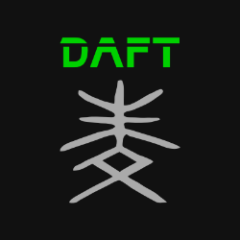
Fan Mission: The Accountant 2: New In Town by Goldwell (2016/05/09)
Daft Mugi replied to Goldwell's topic in Fan Missions
With TDM 2.12, after the credits finished, the "Mission Complete" screen did not display. I found that the screen was black and I could hear my footsteps when I tried to move around. I think the reason for the mission not completing successfully was that the "Do not kill or harm allies" objective was never marked as "1 = STATE_COMPLETE" instead it was left as "0 = STATE_INCOMPLETE". Note, I didn't use noclip throughout the mission. Same as: https://forums.thedarkmod.com/index.php?/topic/18054-fan-mission-the-accountant-2-new-in-town-by-goldwell-20160509/&do=findComment&comment=458491 -
How about using TDM automation framework (and maybe pcem/qemu)? More info see: https://forums.thedarkmod.com/index.php?/topic/19828-automation-features-and-discussion/
-
Woo!! 2.10 Beta "Release Candidate" ( 210-07 ) is out:
https://forums.thedarkmod.com/index.php?/topic/21198-beta-testing-210/
It wont be long now
 ...
...
-
-
 2
2
-
 1
1
-
- Report
-

Can DR be used with engines like Godot?
Skaruts replied to Skaruts's topic in DarkRadiant Feedback and Development
I was just giving this another go, and it seems neither fs_game nor fs_game_base set the actual engine's path. This is the problem I was having before. Looking at other game types in the drop down menu (in the Game Setup window), some of them show that fs_game sets the "Mod" (Mission ) and fs_game_base sets the "Mod Base", and not the "Engine Path". (fs_game is actually useful for Dark Mod mapping, though, for working on multiple projects. Thanks a lot for that. ) What I really need is to launch DR with an engine path (and no Mod or Mod Base at all). Is there a parameter to do that? -
Hello again. I'm almost done with the A-Z beginner tutorial, but I've noticed in some sections of the Dark Radiant wiki they mention an Objectives Editor. It's supposed to be in the Map drop menu, but at least in the v3.8.0 Dark Radiant I have installed (on Linux) there's no Objective Editor to be found. Most mention of it seems to be at least a couple of years old, but was this Editor removed in the latest version of Dark Radiant? Or is this some strange bug on my end?
-
I don't think there's a link to thedarkmod.com on forums.thedarkmod.com ...
-
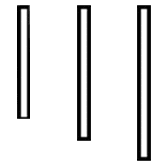
-
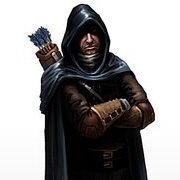
I drew attention to this several times in the last few years. No one payed it any attention, so I just gave up.
-
-
 1
1
-
- Report
-
-
-
Hello, everyone! In this multi-part, comprehensive tutorial I will introduce you to a new light type that has been available in The Dark Mod since version 2.06, what it does, why you would want to use it and how to implement it in your Fan Missions. This tutorial is aimed at the intermediate mapper. Explanations of how to use DarkRadiant, write material files, etc. are outside of its scope. I will, however, aim to be thorough and explain the relevant concepts comprehensively. Let us begin by delineating the sections of the tutorial: Part 1 will walk you through four, distinct ways to add ambient light to a scene, the last way using irradiance environment maps (or IEMs). Lighting a scene with an IEM is considered image-based lighting. Explaining this concept is not in the scope of this tutorial; rather, we will compare and contrast our currently available methods with this new one. If you already understand the benefits IBL confers, you may consider this introductory section superfluous. Part 2 will review the current state of cubemap lights in TDM, brief you on capturing an environment cubemap inside TDM and note limitations you may run into. Three cubemap filtering applications will be introduced and reviewed. Part 3 will go into further detail of the types of inputs and outputs required by each program and give a walkthrough of the simplest way to get an irradiance map working in-game. Part 4 will guide you through two additional, different workflows of how to convert your cubemap to an irradiance map and unstitch it back to the six separate image files that the engine needs. Part 5 will conclude the tutorial with some considerations as to the scalability of the methods hitherto explained and will enumerate some good practices in creating IEMs. Typical scenes will be considered. Essential links and resources will be posted here and a succinct list of the steps and tools needed for each workflow will be summarized, for quick reference. Without further ado, let us begin. Part 1 Imagine the scene. You’ve just made a great environment for your map, you’ve got your geometry exactly how you want it… but there’s a problem. Nobody can appreciate your efforts if they can’t see anything! [Fig. 1] This will be the test scene for the rest of our tutorial — I would tell you to “get acquainted with it” but it’s rather hard to, at the moment. The Dark Mod is a game where the interplay between light and shadow is of great importance. Placing lights is designing gameplay. In this example scene, a corridor with two windows, I have decided to place 3 lights for the player to stealth his way around. Two lights from the windows streak down across the floor and a third, placeholder light for a fixture later to be added, is shining behind me, at one end of the corridor. Strictly speaking, this is sufficient for gameplay in my case. It is plainly obvious, however, that the scene looks bad, incomplete. “Gameplay” lights aside, the rest of the environment is pitch black. This is undesirable for two reasons. It looks wrong. In real life, lights bounce off surfaces and diffuse in all directions. This diffused, omni-directional lighting is called ambient lighting and its emitment can be termed irradiance. You may contrast this with directional lighting radiating from a point, which is called point lighting and its emitment — radiance. One can argue that ambient lighting sells the realism of a scene. Be that as it may, suppose we disregard scary, real-life optics and set concerns of “realism” aside… It’s bad gameplay. Being in darkness is a positive for the player avatar, but looking at darkness is a negative for the player, themselves. They need to differentiate obstacles and objects in the environment to move their avatar. Our current light level makes the scene illegible. The eye strain involved in reading the environment in these light conditions may well give your player a headache, figurative and literal, and greatly distract them from enjoying your level. This tutorial assumes you use DarkRadiant or are at least aware of idtech4’s light types. From my earlier explanation, you can see the parallels between the real life point/ambient light dichotomy and the aptly named “point” and “ambient” light types that you can use in the editor. For further review, you can consult our wiki. Seeing as how there is a danger in confusing the terms here, I will hereafter refer to real life ambient light as “irradiant light”, to differentiate it from the TDM ambient lights, which are our engine’s practical implementation of the optical phenomenon. A similar distinction between “radiant light” and point lights will be made for the same reason. Back to our problem. Knowing, now, that most all your scenes should have irradiant light in addition to radiant light, let’s try (and fail, instructionally) to fix up our gloomy corridor. [Fig. 2] The easiest and ugliest solution: ambient lights. Atdm:ambient_world is a game entity that is basically an ambient light with no falloff, modifiable by the location system. One of the first things we all do when starting a new map is putting an ambient_world in it. In the above image, the darkness problem is solved by raising the ambient light level using ambient_world (or via an info_location entity). Practically every Dark Mod mission solves its darkness problem1 like this. Entirely relying on the global ambient light, however, is far from ideal and I argue that it solves neither of our two, aforementioned problems. Ambient_world provides irradiant light and you may further modulate its color and brightness per location. However, said color and brightness are constant across the entire scene. This is neither realistic, nor does it reduce eye strain. It only makes the scene marginally more legible. Let’s abandon this uniform lighting approach and try a different solution that’s more scene-specific. [Fig. 3] Non-uniform, but has unintended consequences. Our global ambient now down to a negligible level, the next logical approach would be hand-placed ambient lights with falloff, like ambient_biground. Two are placed here, supplementing our window point lights. Combining ambient and point lights may not be standard TDM practice, but multiple idtech4 tutorials extol the virtues of this method. I, myself, have used it in King of Diamonds. For instance, in the Parkins residence, the red room with the fireplace has ambient lights coupled to both the electric light and the fire flame. They color the shadows and enrich the scene, and they get toggled alongside their parent (point) lights, whenever they change state (extinguished/relit). This is markedly better than before, but to be honest anything is, and you may notice some unintended side-effects. The AI I’ve placed in the middle of the ambient light’s volume gets omnidirectionally illuminated far more than any of the walls, by virtue of how light projection in the engine works. Moving the ambient lights’ centers closer to the windows would alleviate this, but would introduce another issue — the wall would get lit on the other side as well. Ambient lights don’t cast shadows, meaning they go through walls. You could solve this by creating custom ambient light projection textures, but at this point we are three ad hocs in and this is getting needlessly complicated. I concede that this method has limited use cases but illuminating big spaces that AI can move through, like our corridor, isn’t one of them. Let’s move on. [Fig. 4] More directional, but looks off. I have personally been using this method in my WIP maps a lot. For development (vs. release), I even recommend it. A point light instead of an ambient light is used here. The texture is either “biground1” or “defaultpointlight” (the latter here). The light does not cast shadows, and its light origin is set at one side of the corridor, illuminating it at an angle. This solves the problem of omnidirectional illumination for props or AI in the middle of the light volume, you can now see that the AI is lit from the back rather than from all sides. In addition, the point light provides that which the ambient one cannot, namely specular and normal interaction, two very important features that help our players read the environment better. This is about as good as you can get but there are still some niggling problems. The scene still looks too monochromatic and dark. From experience, I can tell you that this method looks good in certain scenes, but this is clearly not one of them. Sure, we can use two, non-shadowcasting point lights instead of one, aligned to our windows like in the previous example, we can even artfully combine local and global ambient lights to furnish the scene further, but by this point we will have multiple light entities placed, which is unwieldy to work with and possibly detrimental to performance. Another problem is that a point light’s movable light origin helps combat ambient omnidirectionality, but its projection texture still illuminates things the strongest in the middle of its volume. I have made multiple experiments with editing the Z-projection falloff texture of these lights and the results have all left me unsatisfied. It just does not look right. A final, more intellectual criticism against this method is that this does not, in a technical sense, supply irradiant light. Nothing here is diffuse, this is just radiant light pretending the best it can. [Fig. 5] The irradiance map method provides the best looking solution to imbuing your scene with an ambient glow. This is the corridor lit with irradiance map lights, a new lighting method introduced in The Dark Mod 2.06. Note the subtle gradients on the left wall and the bounced, orange light on the right column. Note the agreeable light on the AI. Comparing the previous methods and this, it is plainly obvious that an irradiance environment map looks the most realistic and defines the environment far better than any of the other solutions. Why exactly does this image look better than the others? You can inform yourself on image-based lighting and the nature of diffuse irradiance, but images speak louder than words. As you can see, the fact of the matter is that the effect, subtle as it may be, substantially improves the realism of the scene, at least compared to the methods previously available to us. Procuring irradiance environment maps for use in lighting your level will hereafter be the chief subject of this tutorial. The next part will review environment cubemap capture in TDM, the makeIrradiance keyword and three external applications that you can use to convert a TDM cubemap into an irradiance map. 1 “ Note that the color buffer is cleared to black: Doom3 world is naturally pitch black since there is no "ambient" light: In order to be visible a surface/polygon must interact. with a light. This explains why Doom3 was so dark ! “ [source] Part 2 Cubemaps are not new to The Dark Mod. The skybox materials in some of our prefabs are cubemaps, some glass and polished tile materials use cubemaps to fake reflections for cheap. Cubemap lights, however, are comparatively new. The wiki page linked earlier describes these two, new light types that were added in TDM 2.05. cubicLight is a shadow-casting light with true spherical falloff. An example of such a light can be found in the core files, “lights/cubic/tdm_lampshade_cubic”. ambientCubicLight is the light type we will be focusing on. Prior to TDM 2.06, it acted as a movable, on-demand reflection dispenser, making surfaces in its radius reflect a pre-set cubemap, much like glass. After 2.06, the old behavior was discarded and ambientCubicLight was converted to accept industry standard irradiance environment maps. Irradiance environment maps (IEMs) are what we want to make, so perhaps the first thing to make clear is that they aren’t really “handmade”. An IEM is the output of a filtering process (convolution) which requires an input in the form of a regular environment cubemap. In other words, if we want to make an IEM, we need a regular cubemap, ideally one depicting our environment — in this case, the corridor. I say a snapshot of the environment is ideal for lighting it because this emulates how irradiant light in the real world works. All radiating surfaces are recorded in our cubemap, our ambient optic array as it were, then blurred, or convoluted, to approximate light scatter and diffusion, then the in-game light “shines” this approximation of irradiant light back to the surfaces. There is a bit of a “chicken and the egg” situation here, if your scene is dark to begin with, wouldn’t you just get a dark irradiance map and accomplish nothing? In the captured cubemap faces in Fig. 6, you may notice that the environment looks different than what I’ve shown so far. I used two ambient lights to brighten up the windows for a better final irradiance result. I’ve “primed the pump”, so to speak. You can ignore this conundrum for the moment, ways to set up your scenes for better results, or priming the pump correctly, will be discussed at the end of the tutorial. Capturing the Environment The wiki has a tutorial on capturing cubemaps by angua, but it is woefully out of date. Let me run you through the process for 2.07 really briefly. To start with, I fly to approx. the center of the corridor with noclip. I then type “envshot t 256” in the console. This outputs six .tga images in the <root>/env folder, simply named “t”, sized 256x256 px and constituting the six sides of a cube and depicting the entire environment. This is how they look in the folder: [Fig. 6] The six cube faces in the folder. Of note here is that I do not need to switch to a 640x480 resolution, neither do I need to rename these files, they can already be used in an ambientCubicLight. Setting Up the Lights For brevity’s sake, I’ll skip explaining material definitions, if you’ve ever added a custom texture to your map, you know how to do this. Suffice it to say, it is much the same with custom lights. In your <root>/materials/my_cool_cubemaps.mtr file, you should have something like this: lights/ambientcube/my_test_IEM_light { ambientCubicLight { forceHighQuality //cameraCubeMap makeIrradiance(env/t) cameraCubeMap env/t colored zeroClamp } } We’ll play with the commented out line in just a bit. Firstly, let’s place the actual light in DarkRadiant. It’s as simple as creating a new light or two and setting them up in much the same way you would a regular ambient light. I select the appropriate light texture from the list, “my_test_IEM_light” in the “ambientcube” subfolder and I leave the light colored pure white. [Fig. 7] The corridor in DR, top view, with the ambient cubic lights highlighted. I can place one that fills the volume or two that stagger the effect somewhat. Remember that these lights still have a spherical falloff. Preference and experimentation will prove what looks best to you. Please note that what the material we defined does is load a cubemap while we established that ambientCubicLights only work with irradiance maps. Let’s see if this causes any problems in-game. I save the map and run it in game to see the results. If I already have TDM running, I type “reloadDecls” in the console to reload my material files and “reloadImages” to reload the .tga images in the /env folder. [Fig. 8] Well this looks completely wrong, big surprise. Wouldn’t you know it, putting a cubemap in the place of an irradiance map doesn’t quite work. Everything in the scene, especially the AI, looks to be bathed in slick oil. Even if a material doesn’t have a specular map, it won’t matter, the ambientCubicLight will produce specular reflections like this. Let’s compare how our cubemap .tga files compares with the IEM .tgas we’ll have by the end of the tutorial: [Fig. 9] t_back.tga is the back face of the environment cubemap, tIEM_back.tga is the back face of the irradiance map derived from it. As you can see, the IEM image looks very different. If I were to use “env/tIEM” instead of “env/t” in the material definition above, I would get the proper result, as seen in the last screenshot of part 1. So it is that we need a properly filtered IEM for our lights to work correctly. Speaking of that mtr def though, let’s not invoke an irradiance map we haven’t learned to convert yet. Let’s try an automatic, in-engine way to convert cubemaps to IEMs, namely the makeIrradiance material keyword. makeIrradiance and Its Limitations Let’s uncomment the sixth line in that definition and comment out the seventh. cameraCubeMap makeIrradiance(env/t) //cameraCubeMap env/t Here is a picture of how a cubemap ran through the makeIrradiance keyword looks like: [Fig. 10] Say ‘Hi’ to our friend in the back, the normalmap test cylinder. It’s a custom texture I’ve made to demonstrate cubemap interactions in a clean way. Hey now, this looks pretty nice! The scene is a bit greener than before, but you may even argue it looks more pleasing to the eyes. Unfortunately, the devil is in the details. Let’s compare the makeIrradiance keyword’s output with the custom made irradiance map setup seen at the end of part 1. [Fig. 11, 12] A closer look at the brick texture reveals that the undesired specular highlighting is still present. The normal map test cylinder confirms that the reason for this is the noisy output of the makeIrradiance keyword. The in-engine conversion is algorithmic, more specifically, it doesn't allow us to directly compare .tga files like we did above. Were we able to, however, I'm sure the makeIrradiance IEM would look grainy and rough compared to the smooth gradient of the IEM you’ll have by the end of this tutorial. The makeIrradiance keyword is good for quick testing but it won’t allow you fine control over your irradiance map. If we want the light to look proper, we need a dedicated cubemap filtering software. A Review of Cubemap Filtering Software Here I’ll introduce three programs you can produce an irradiance map with. In the coming parts, I will present you with a guide for working with each one of them. I should also note that installing all of these is trivial, so I’ll skip that instructional step when describing their workflows. I will not relay you any ad copy, as you can already read it on these programs’ websites. I’ll just list the advantages and disadvantages that concern us. Lys https://www.knaldtech.com/lys/ Advantages: Good UI, rich image manipulation options, working radiance/specular map filtering with multiple convolution algorithms. Disadvantages: $50 price tag, limited import/export options, only available on Windows 64-bit systems. cmftStudio https://github.com/dariomanesku/cmftStudio Advantages: Available on Windows, OSX and Linux, free, open source software, command line interface available. Disadvantages: Somewhat confusing UI, limited import options, missing features (radiance/specular map filtering is broken, fullscreen doesn’t work), 32-bit binaries need to be built from source (I will provide a 32-bit Windows executable at the end of the tutorial). Modified CubeMapGen https://seblagarde.wordpress.com/2012/06/10/amd-cubemapgen-for-physically-based-rendering/ Advantages: Free software, quickest to work with (clarified later). Disadvantages: Bad UI, only Windows binaries available, subpar IEM export due to bad image adjustment options. Let’s take a break at this point and come back to these programs in part 3. A lot of caveats need to be expounded on as to which of these three is the “best” software for making an irradiance map for our purposes. Neither of these programs has a discreet workflow; rather, the workflow will include or exclude certain additional programs and steps depending on which app you choose to work with. It will dovetail and be similar in all cases. Part 3 The aim of this tutorial is twofold. First, it aims to provide the most hands-free and time-efficient method of converting an envshot, environment cubemap to an IEM and getting it working in-game. The second is using as few applications as possible and keeping them all free software that is available for download, much like TDM itself. The tutorial was originally going to only cover IEM production through Lys, as that was the app I used to test the whole process with. I soon realized that it would be inconsiderate of me to suggest you buy a fifty dollar product for a single step in a process that adds comparatively little to the value of a FM, if we’re being honest (if you asked me, the community would benefit far more from a level design tutorial than a technical one like this, but hey, maybe later, I’m filling a niche right now that nobody else has filled). This led me to seek out open-source alternatives to Lys, such as Cubemapgen, which I knew of and cmftStudio, which I did not. I will preempt my own explanations and tell you right away that, in my opinion, cmftStudio is the program you should use for IEM creation. This comes with one big caveat, however, which I’m about to get into. Six Faces on a Cross and The Photoshop Problem Let’s review. Taking an envshot in-game gives you six separate images that are game-ready. Meaning, you get six, split cubemap faces as an output, you need six, split irradiance map faces as an input. This is a problem, because neither Lys nor cmftStudio accept a sequence of images as such. They need to be stitched together in a cube cross, a single image of the unwrapped cube, like this: [Fig. 13] From Lys. Our cubemap has been stitched into a cross and the “Debug Cube Map Face Position” option has been checked, showing the orientations of each face. In Lys only panoramas, sphere maps and cube maps can be loaded into the program. The first two do not concern us, the third specifically refers to a single image file. Therefore, to import a TDM envshot into Lys you need to stitch your cubemap into a cross. Furthermore, Lys’ export also outputs a cubemap cross, therefore you also need to unstitch the cubemap into its faces afterwards if you want to use it in TDM. In cmftStudio you can import single map faces! Well… no, you can’t. The readme on GitHub boasts “Input and output types: cubemap, cube cross, latlong, face list, horizontal and vertical strip.” but this is false. The UI will not allow you to select multiple files on import, rendering the “face list” input type impossible.2 Therefore, to import a TDM envshot into cmftStudio you need to stitch your cubemap into a cross. Fortunately, the “face list” export type does work! Therefore, you don’t need to unstitch the cubemap manually, cmftStudio will export individual faces for you. In both of these cases, then, you need a cubemap cross. For this tutorial I will use Adobe Photoshop, a commercial piece of software, to stitch our faces into a cubemap in an automated fashion (using Photoshop’s Actions). This is the big caveat to using cmftStudio, even if you do not want to buy Lys, PS is still a prerequisite for working with both programs. There are, of course, open source alternatives to Photoshop, such as GIMP, but it is specifically Photoshop’s Action functionality that will power these workflows. GIMP has its own Actions in the form of Macros, but they are written with python. GIMP is not a software suite that I use, neither is python a language I am proficient with. Out of deference for those who don’t have, or like working with, Photoshop, I will later go through the steps I take inside the image editor in some detail, in order for the studious reader to reconstruct them, if they so desire, in their image editing software of choice. At any rate, and at the risk of sounding a little presumptuous, I take it that, as creative types, most of you already have Photoshop on your computers. 2 An asterisk regarding the “impossibility” of this. cmftStudio is a GUI for cmft, a command line interface that does the same stuff but inside a command prompt. I need to stress that I am certain multiple faces can be inputted in the command line, but messing with unwieldy prompts or writing batch files is neither time-saving nor user-friendly. This tutorial is aimed at the average mapper, but a coder might find the versatility offered in cmft interesting. The Cubemapgen Workflow You will have noticed that I purposefully omitted Cubemapgen from the previous discussion. This is because working with Cubemapgen, wonderfully, does not need Photoshop to be involved! Cubemapgen both accepts individual cubemap faces as input and exports individual irradiance map faces as output. Why, then, did I even waste your time with all the talk of Lys, cmftStudio and Photoshop? Well, woefully, Cubemapgen’s irradiance maps look poor at worst and inconsistent at best. Comparing IEMs exported from Lys and cmftStudio, you will see that both look practically the same, which is good! An IEM exported from Cubemapgen, by default, is far too desaturated and the confusing UI does not help in bringing it to parity with the other two programs. If you work solely with Cubemapgen, you won’t even know what ‘parity’ is, since you won’t have a standard to compare to. [Fig. 14] A comparison between the same irradiance map face, exported with the different apps at their respective, default settings. Brightened and enlarged for legibility. This may not bother you and I concede that it is a small price to pay for those not interested in working with Photoshop. The Cubemapgen workflow is so easy to describe that I will in fact do just that, now. After I do so, however, I will argue that it flies in the face of one of the aims of this tutorial, namely: efficiency. Step 1: Load the cubemap faces into Cubemapgen. Returning to specifics, you will remember that we have, at the moment, six .tga cubemap faces in a folder that we want to convert to six irradiance map faces. With Cubemapgen open, direct your attention to these buttons: [Fig. 15] You can load a cubemap face by pressing the corresponding button or using the hotkey ‘F’. To ensure the image faces the correct way, you must load it in the corresponding “slot”, from the Select Cubemap Face dropdown menu above, or by pressing the 1-6 number keys on your keyboard. Here is a helpful list: X+ Face <1> corresponds to *_right X- Face <2> corresponds to *_left Y+ Face <3> corresponds to *_up Y- Face <4> corresponds to *_down Z+ Face <5> corresponds to *_forward Z- Face <6> corresponds to *_back ...with the asterisk representing the name of your cubemap. With enough practice, you can get quite proficient in loading cubemap faces using keyboard shortcuts. Note that the ‘Skybox’ option in the blue panel is checked, I recommend you use it. Step 2: Generate the Irradiance Map [Fig. 16] The corridor environment cubemap loaded in and filtered to an irradiance map. The options on the right are my attempt to get the IEM to look right, though they are by no means prescriptive. Generating an IEM with Modified CubeMapGen 1.66 is as easy as checking the ‘Irradiance cubemap’ checkbox and hitting ‘Filter Cubemap’ in the red panel. There are numerous other options there, but most will have no effect with the checkbox on. For more information, consult the Sébastien Lagarde blog post that you got the app from. I leave it to you to experiment with the input and output gamma sliders, you really have no set standard on how your irradiance map is supposed to look, so unfortunately you’ll have to eyeball it and rely on trial and error. Two things are important to note. The ‘Output Cube Size’ box in the red panel is the resolution that you want your IEM to export to. In the yellow panel, make sure you set the output as RGB rather than RGBA! We don’t need alpha channels in our images. Step 3: Export Irradiance Map Faces Back in the green panel, click the ‘Save CubeMap to Images’ button. Save the images as .tga with a descriptive name. [Fig. 17] The exported irradiance map faces in the folder. These files still need to be renamed with appropriate suffixes in order to constitute a readable cubemap for the engine. The nomenclature is the same as the table above: “c00” is the X+ Face, to be renamed “right”, “c01” is the X- Face and so on. Right left, up down, forward and back. That’s the order! This is all there is to this workflow. A “cameraCubeMap env/testshot” in the light material will give us a result that will look, at the very least, better than the inbuilt makeIrradiance material keyword. [Fig. 17] The map ended up being a little bright. Feel free to open Fig. 4 and this in seperate tabs and compare the Lys/cmft export with the cubemapgen one. A Review of the Workflow Time for the promised criticism to this workflow. I already stated my distaste for the lack of a standardised set of filtering values with this method. The lack of any kind of preset system for saving the values you like makes working with Cubemapgen even more slipshod. Additionally, in part 2, I said that Cubemapgen is the fastest to work with, but this needs to be qualified. What we just did was convert one cubemap to an irradiance map, but a typical game level ought to use more than a single IEM. Premeditation and capturing fake, “generic” environment cubemaps (e.g. setting up a “blue light on the right, orange on the left” room or a “bright skylight above, brown floor” room, then capturing them with envshot) might allow for some judicious reuse and keep your distinct IEM light definition count down to single digits, but you can only go so far with that. I am not arguing here for an ambient cubic light in every scene either, certainly only those that you deem need the extra attention, or those for which the regular lighting methods enumerated in Part 1 do not quite work. I do tentatively assume, though, that for an average level you would use between one and two dozen distinct IEMs. Keep in mind that commercial games, with their automated probe systems for capturing environment shots, use many, many more than that. With about 20 cubemaps to be converted and 6 faces each to load into Cubemapgen, you’ll be going through the same motions 120 whole times (saving and renaming not included). If you decide to do this in one sitting (and you should, as Cubemapgen, to reiterate, does not keep settings between sessions), you are in for a very tedious process that, while effective, is not very efficient. The simple fact is that loading six things one by one is just slower than loading a single thing once! The “single thing” I’m referring to is, of course, the single, stitched cubemap cross texture. In the next part, I will go into detail regarding how to make a cubemap cross in Photoshop in preparation for cmftStudio and Lys. It will initially seem a far more time-consuming process to you than the Cubemapgen workflow, but through the magic of automation and the Actions feature, you will be able to accomplish the cubemap stitch process in as little as a drag-and-drop into PS and a single click. The best thing is that after we go through the steps, you won’t have to recreate them yourself, as I will provide you with a custom Actions .atn file and save you the effort. I advise you not to skip the explanations, however. The keen-eyed among you may have noticed that you can also load a cube cross in Cubemapgen. If you want to use both Cubemapgen and Photoshop together to automate your Cubemapgen workflow, be aware that Cubemap gen takes crosses that have a different orientation than the ones Lys and cmftStudio use. My macros (actions) are designed for the latter, so if you want to adjust them for Cubemapgen you would do well to study my steps and modify them appropriately. For the moment, you’ve been given the barebones essentials needed to capture an envshot, convert it to an irradiance map and put it in your level at an appropriate location, all without needing a single piece of proprietary software. You can stop here and start cranking out irradiance maps to your heart’s content, but if you’re in the mood for some more serious automation, consider the next section.
-
If the "mission fails as soon as stealth score turns non-zero," that would not be good for ghost players. They might need to find out "how" they failed and experiment to avoid alerting guards. They might need to take those score points as a "bust". They might need to take those score points to complete an objective. Then, mission authors would need to encode exceptions into their missions, which would be a lot of work (if they decide to do it at all). However, part of what makes ghosting challenging and fun is when mission authors do not create their missions with ghosting in mind. Please see: Official Ghosting Rules: https://www.ttlg.com/forums/showthread.php?t=148523 Writing code for these rules would be a huge undertaking. Ghost Rules Discussion: https://www.ttlg.com/forums/showthread.php?t=148487 Creating an official mode could alienate these dedicated ghost players, because it would clash with what is considered ghosting in the community. Including the Stealth Stat Tool mod in the official release would be more useful. Or, making the audible alert states of guards quick and easy to recognize could help as well. For these reasons, I don't agree with an official "Ghost" mode. If the dev team were to do it, we should consult with @Klatremus so we get it 100% correct or not pursue it at all. (This ghosting bit should probably be in its own thread.)
-
There's no forum feedback section, so I post it here. So I think the Dark forum theme is not dark enough (for me) and some of the graphics are not good. So I did some css edits and implemented these on the forum via the Stylus plugin for Firefox (or Chrome). There are other solutions to directly alter forum css, but I will not go into that for now. To make it look properly you have to first activate the default dark theme of this forum (which is weird enough not the default theme), if you've not done that yet (scroll to the bottom middle part of the forum, where there's a pulldown menu called theme). Here is my current code: You can try it out and see how it looks. It also improves the looks of the like buttons on the side. I keep tweaking it and updating this post, so it might not completely look like in the supplied screenshots. Summery of extra custom edits that are more opinionated:
-
To cater to both audiences. I mentioned LibreGameWiki as one example. nbohr1more mentioned other uses. Explicitly allowing reuse and spread will help TDM reach a wider audience and would hopefully attract more volunteers. More volunteers which can help improve both TDM versions. There are several benefits for a project of being in the Debian repo. One is that TDM Debian-users can report defects on any package directly to Debian (no need to register on separate forums). Debian may then fix the issue themselves (in their "TDM-libre" package) and will offer the patch upstream to TDM, who can then choose to accept or reject the patch. I envision "TDM-libre" to have the same capability of downloading any mission as regular TDM. The only difference is that "TDM-libre" would come packaged with the regular engine (which is GPL+BSD) and an included mission that has libre media/gamedata. When I play TDM by myself, I want the unlimited-play and can accept commercial restrictions. But if I were to promote it somewhere, or charge for a stream when playing online, or make a video, I would want a version without commercial restrictions (and can temporarily accept limited-play) to make sure I don't violate anyone's copyright. Perhaps. That's what I'm trying to find out.
-
In High Expectations, I used a custom water material because I wanted a water surface that was dark and not entirely transparent. It looked pretty decent and I am using it in my next FM as well. However in 2.12 the water material has a greenish tinge to it (see attached screenshots). Here is the material - it's basically 'water_stream' with a blend stage using matt black: https://github.com/FrostSalamander/fsx/blob/main/materials/fs_water_stream_dark.mtr These screenshots have the brightness and gamma cranked up to maximum, because the difference is subtle (but noticeable) on normal levels and the screenshots were way too dark without it. High Expectations: WIP FM:

